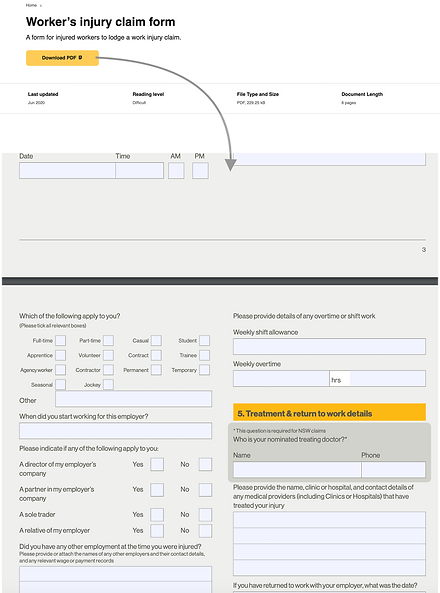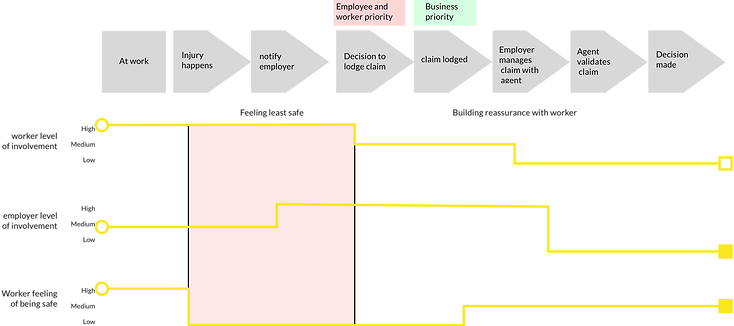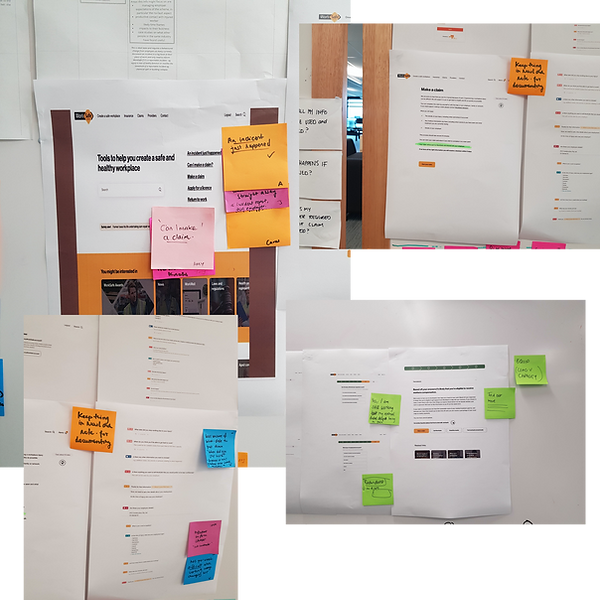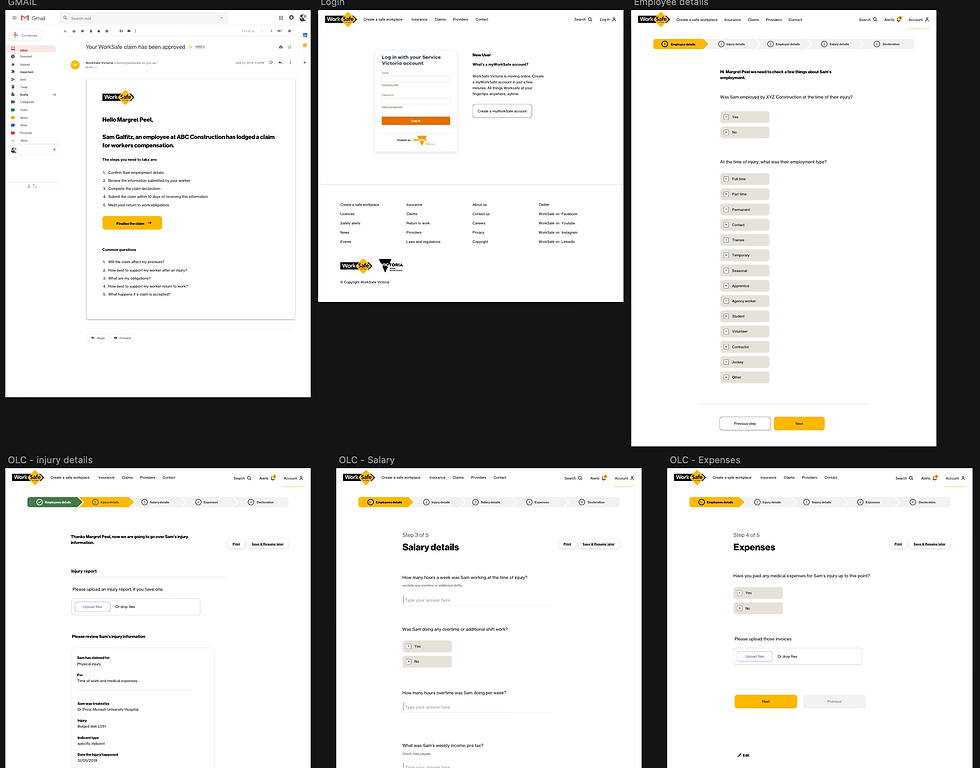
Digital workplace injury claim form
Overview
We designed a website to digitalise the complex work injury claim process with Worksafe. It outlined important steps in lodging a successful injury claim report.
The team worked towards creating a transparent claim environment by providing relevant information throughout the process. The information reassured the users and made it easier to determine the claim. It inculcated trust and provided privacy to the user.
Disclaimer: All views expressed here are my own and do not necessarily reflect the views of the respective company. Some design elements have been changed from the original.
Problem
We wanted to digitalize and eliminate the stigma for the claim lodgement process. The design provided a system where both parties can have true knowledge about their rights and develop trust in the system.
- Stigma about the claim
- Language barrier
- Position against their employer
- Becoming redundant
- Unaware of their rights
- Claim within the timeframe
The current version of the initial lodgement form
currently, the form ought to be manually filled and posted

80% of mental health injury at workplace get
unheard, and it's still a taboo in society
Solution
We followed the agile model that consisted of one sprint that lasted 2 weeks of user testing and iteration. Further, run 1 week of the discovery phase to outline the purpose for the project and interconnect systems by gathering the necessary information to build new features.
We compiled existing questions in a digital format with newly discovered questions at the discovery phase and tested them amongst users.
We eventually created and shipped a fully functional prototype meeting the business needs where users can feel more confident about the lodgement process.
My role: User research, UI and testing
The team included UI/UX designer(me), a product development crew, an innovation lead and the project coordinator.
I worked on aspects of the new design system including UI design, wireframing, logic creation, flows, journey and testing. I revamped the UX of key pages while my colleagues helped me implement the design.
Responsibility
Ideation, user flows,
rapid prototype & testing, research
Timeline and output
4 weeks to design, shape a legislative web application for employer and employee
Team
Innovation team, lead CX, project coordinator and legislative content writer, product development team.
Discovery and users
Workers who have been injured at work ultimately want to recover and get back to work.
But on top of focussing on getting better, workers need to navigate a complex and confusing system associated with longstanding stigma and unfair judgement.
Workers and employers needed access to trustworthy, timely and easy-to-understand information relevant to their situation so that they can make considered decisions that align with their needs & sense of purpose.

Some insight from initial interviews
A worker with a mental injury needs the system to recognize the signs that they are in need of help and get connected to appropriate support at the right time.
Workers need a claim experience that enables them to feel safe, encourages them, builds confidence for positive action.
Workers need to know why their information is needed, how it will be presented?
Workers and employers should be able to tell their story
Workers were delaying their decision to make claim
Some reasons from findings
- Influenced by negative and non-regulated information
- Fear of their employers
- Don't know whether if they are covered against being made redundant
- Scared how their information will be used by the employer or future employer against them
- Will impact their career and reputation
- Lack of understanding of what they are entitled to
- The process does not indicate support to return to work or find work
- Will create stress in the family
Define
WHAT
We are trying to solve this complex claim lodgement.
WHY
To make it easier for the worker to decide to claim.
- Makes it easier to decide if they should claim
- Is trustworthy
- Makes them feel safe
- Is clear
- Provides reassurance and alleviates
HOW
We started to define the journey of employers and employees, how they will interact with the new tool and what kind of steps will they take for successful lodgement without the hustle and bustle.

We decided on finding a solution that focused on the question
How might we reduce the time taken to decide to claim and remove barriers so that injured workers & employers feel safe, confident and reassured that Worksafe would resolve their situation?

Task flow
We decided to break down the process into a more assessable and easy-to-understand process where users can feel comfortable and confident in their decision-making.
Eligibility quiz
Sign-in page
Landing page
Personal Info
Details
Employer form
Employee form
Consent
Review
Submit
Triage
Rate your experience
Exploring and Designing
We developed an additional questionnaire, logic flow for eligibility quiz where an open conversation was designed to answer employer and employee questions about their specific situation and self-direct their search to receive clear and trustworthy explanations and understand whether they are eligible to claim.

Eligibility Quiz
Final UI for testing. We added and subtracted questions that followed legislative rules. We also took care of language and crafted it in a manner that users feel empathy and trust with the system. Our finding suggested the tone is also an essential part of making users feel confident.

The logic flows for employer and employee.
Before designing wireframes and UI, we decided to make a logic flow for questions within the form.
We wanted to define logic creation for both forms. We carried out multiple alterations to achieve the right content and link all possible answers.

Defining
Based on the logic, we need to divide flow according to segments of the questions asked in every step and identified the following steps for worker form.
-
Personal details
-
Injury details
-
Employer details
-
Consent
-
Review
-
Submit

We kicked off 2 weeks of sprint designed sprint which consisted of testing workers and employers.
19 workers
First half claimed for workers compensation
Second half experiencing injury at work and had not put claim
11 Employers
Medium to the large form of industries with highest claim volumes and have managed workers compensation claims
User testing
We kicked off 2 weeks of designed sprint which consisted of testing workers and employers.
Method
Notes, screen recordings (prototype) and voice recording
Time
1 hour each participant
19 workers
First half claimed for workers compensation
Second half experiencing injury at work and had not claimed
11 Employers
Medium to the large industries with the highest claim volumes and have managed workers compensation claims
Concept: Claim form and eligibility
Concept description tested:
An open conversation designed to answer employer and employee questions about their specific situation and direct them to available options to resolve their concerns.
How does it address the problem?
Workers have the opportunity to self-direct their search and receive clear, trustworthy answers to help them understand whether they can make a claim.
What employers and workers told us:
Workers showed strong interest in concept description, identifying question and answer tool that would have been beneficial in their circumstances. Employers saw the value in being able to direct their workers to such a tool.
The prototype was very specific to the requirements for eligibility. All the workers involved in testing had experienced injuries that clearly met eligibility for workers compensation. Therefore the test indicated that the concept was desirable.
Sprint 1
In the sprint plan phase scrum team decide to meet with “User Stories” which define functions that will from the perspective of the customer and their needs.
User story: As a first-time customer, I want to make a claim to get support.
Testing is the key in the Agile Model since it allows the team to continuously and easily test both the original and new functions as the product is updated in a sprint.

Prototype testing of concepts was completed, with the iterations made after each round. Each cycle consisted of 3-5 workers and employers.
After collecting the recordings from the user interviews, I conducted affinity mapping with my teammates to synthesize the pains identified. We grouped these under Positive (+), Negative (-), IDEAS and DOUBTS

Results and takeaways
There was an overwhelmingly positive response to the claim form. It was positively handled by workers and employers.
Easy, stress-free, able to tell their story, fewer steps, informative, enables workers to initiate the claim rather than wait for their employer to do something about their situation
Workers with mental health need examples of cases like theirs because it is less common to hear of others going through such situations.
Some highlights
-
Some workers needed to know more about workers compensation including what it covered and details around the process, such as timeframes and costs before being able to proceed.
-
Some did not even know what is a claim or such thing even existed and was keen to understand the power of it.
-
Most of them were worried if they will be in a problem or trouble with their employer and the impact of the claim in their life.
-
It also came in notice that even after encouraged by doctor and employer for the claim they highly delayed or never made the claim.
Some questions were surrounded by "if I am eligible?"
-
What if I am made redundant?
-
I am redundant
-
I was injured on-premises but out of working hours
-
I was injured at home during work from home
-
I was injured but I am not sure it was at work